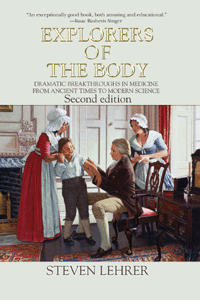

![]() CONTENTS
CONTENTS
INTRODUCTION
CHAPTER ONE Muscle and Blood
Of Pumps and Valves; The Flower of English Medicine; The Flame of Life
CHAPTER TWO DNA: The Spiral Threads of Heredity
The Curious Mendel; Dividends from Pus; The Last Parts of the Puzzle; The
Pneumococcus and the Two Freds; The Transforming Principle and Oswald Avery; The
Path to the Double Helix; DNA Today
CHAPTER THREE The White Light: Surgical Anesthesia
The Painful Knife; Laughing Pain Away; Anesthesia by Suffocation; Anesthesia by
Suggestion; Chemical Anesthesia
CHAPTER FOUR Infection
A Few Words About Wounds; Epidemiology and Semmelweis; The Germ Theory; Pasteur;
From Lister to Listerine
CHAPTER FIVE The Rise of the Scalpel
The First Advance; The Corpse Crunch; Early Aseptic Surgery; Halsted; Harvey
Cushing and Neurosurgery; Dr. Young and Diamond Jim; Dr. Kelly and God
CHAPTER SIX The Search for Microbes
Robert Koch and Anthrax; Koch and the White Plague; Koch and the Vibrio of
Cholera; The Tuberculin Fiasco; Pasteur and the Bacteria of Animal Disease;
Toxin, Antitoxin, and Money; Microbes and Vectors; Filariasis; The Fever of Bad
Air; Cinchona, the Countess's Powder; The Parasite; The Vector of Malaria;
Mosquito Manson's Inspiration; Ross and the Birds; Unpleasantness; Two Tales of
the Golden Age
CHAPTER SEVEN The Chemotherapy of Infection
The Great Pox and the Magic Bullet; "Sir Almost Right"; Fleming's Discoveries;
Penicillin in Limbo; More Failures; Early Penicillin Therapy; The Acceptance of
Chemotherapy; Antagonisms; The Fight Over Streptomycin
CHAPTER EIGHT The Search for Invisible Poisons: Viruses
Smallpox; Mad dogs and Frenchman; Yellow jack; A man a plan a canal Panama;
Yellow fever: germ and vaccine; Poliomyelitis; AIDS
CHAPTER NINE Rays
X-rays; Radioactivity
CHAPTER TEN Diabetes Mellitus and Insulin
CHAPTER NOTES
BIBLIOGRAPHY
INDEX
Acknowledgments
I wish to thank the following persons for their help: Arlene Shaner, New York
Academy of Medicine; Professor Robert Austrian, University of Pennsylvania
School of Medicine; Professor Maclyn McCarty, Rockefeller University; Carmen
Lorenz, Bundesarchiv, Berlin; Ulrike Folkens, Robert Koch Institute, Berlin; Ron
Fraser, Society for General Microbiology, London; Mildred Marmur, Mildred Marmur
Associates, Larchmont, New York.
INTRODUCTION
The art of healing is an old one. It antedates even the evolution of modern man
more than one hundred thousand years ago and is also practiced by other
primates. Chimpanzees, for example, have been observed to perform certain
medical maneuvers on each other. They extract splinters from hands and feet with
a method humans use: levering the splinter upward with two fingernails, to be
caught and removed by the teeth. In Louisiana's Delta Regional Primate Center
one chimp was photographed using a red cedar twig to pull a deciduous tooth from
the mouth of another.
The science of healing is somewhat newer than the art. The decisive turn from
supernaturalism to naturalistic, rational explanations of disease appears to
have been made in Greece, sometime between 500 B.C. and A.D. 500. Hippocrates, a
Greek physician, is generally credited with this innovation in medical thought.
Very little is known about Hippocrates. He was born on the small island of Cos,
in the Aegean Sea, about 460 B.C. Evidently he traveled widely, and the writings
of Plato and Aristotle indicate that he achieved great renown during his long
life. While his existence cannot be doubted, most of the manuscripts attributed
to him are of questionable authenticity.
Numerous contributions to the science of healing have been made since
Hippocrates' time. A few, because of their revolutionary nature, stand out from
the rest. This book tells the story of these great discoveries and of the men
and women responsible for them.

